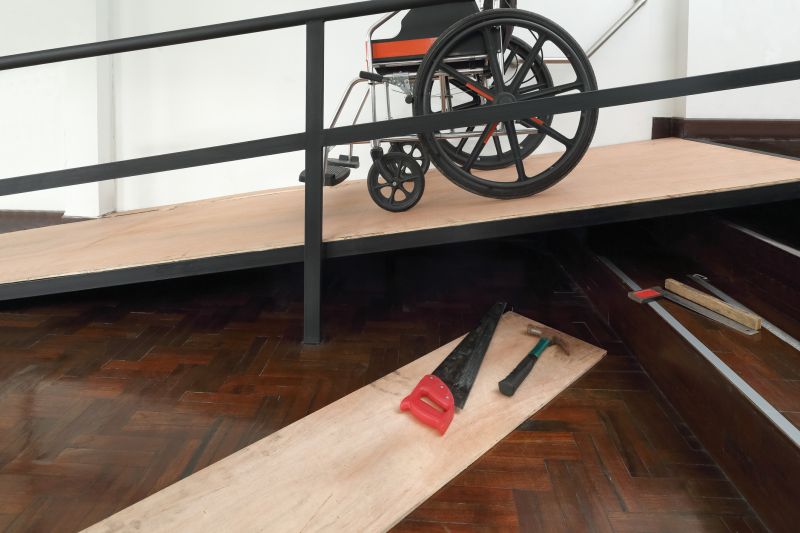Top-Rated Products For Professional Wheelchair Ramp Installations
Choose from high-performance products that meet safety standards and simplify the installation process.
 Wheelchair ramp installations are essential solutions that enhance accessibility for individuals with mobility challenges. Selecting the right products ensures safety, durability, and ease of use. Ramps can be customized to fit various environments, from residential entrances to commercial facilities, making it important to understand the different options available. Proper installation not only improves independence but also complies with accessibility standards.
Wheelchair ramp installations are essential solutions that enhance accessibility for individuals with mobility challenges. Selecting the right products ensures safety, durability, and ease of use. Ramps can be customized to fit various environments, from residential entrances to commercial facilities, making it important to understand the different options available. Proper installation not only improves independence but also complies with accessibility standards.
Top Overall Option
Modular Aluminum Wheelchair Ramp System
This versatile modular aluminum ramp system offers customizable lengths and widths, making it suitable for various installation scenarios. Its lightweight yet durable construction provides stability and ease of transport. Features such as non-slip surfaces and integrated handrails enhance safety, while simple assembly allows for quick setup without specialized tools.
Types of Products For Wheelchair Ramp Installations
Portable Folding Ramps
Designed for temporary or mobile use, these ramps can be folded for easy transport and storage, ideal for travel or short-term needs.
Modular Aluminum Ramps
Customizable and expandable, these ramps are built for permanent or semi-permanent installations with a focus on durability and safety.
Threshold Ramps
Small ramps designed to bridge door thresholds or small elevation changes, providing smooth transitions in tight spaces.
Vehicle Ramps
Specialized ramps designed for loading and unloading wheelchairs from vehicles, offering portability and stability.
Permanent Concrete Ramps
Built into the landscape, these ramps provide a sturdy, long-term solution suitable for outdoor environments.
Steel Ramps
Heavy-duty ramps made from steel, offering high weight capacities and durability for commercial or high-traffic areas.
Wooden Ramps
Traditional ramps constructed from treated wood, suitable for custom projects with aesthetic considerations.
Adjustable Ramps
Ramps with adjustable height features, allowing customization to different elevation levels with ease.
Threshold Plate Ramps
Low-profile ramps that can be placed over thresholds to facilitate wheelchair access without significant modifications.
Outdoor Stair Ramps
Designed specifically to convert stairs into accessible pathways, often with non-slip surfaces and sturdy framing.
Indoor Modular Ramps
Designed for indoor use, these ramps can be integrated into existing flooring and are often lightweight and easy to move.
Vehicle Lift Ramps
Integrated with vehicle lifts or platforms, these ramps assist with vehicle accessibility for wheelchair users.
Popular Choices
Highly favored for their portability and ease of storage, suitable for temporary or travel use.
Popular for their adaptability and lightweight construction, ideal for various permanent installations.
Commonly used to overcome small elevation changes at doorways, offering quick and simple solutions.
Frequently chosen for their portability and ease of loading wheelchairs into vehicles.
Preferring durability, these ramps are often installed permanently in outdoor settings.
Selected for high weight capacity and robustness, suitable for high-traffic environments.
Popular for their flexibility in accommodating different height requirements with minimal effort.
Chosen for converting stairs into accessible pathways with safety features.
Favored for their ease of integration into indoor spaces and portability.
When considering products for wheelchair ramp installations, factors such as material durability, weight capacity, ease of assembly, and safety features are crucial. Many products are designed to withstand weather conditions and heavy usage, providing long-term reliability. Additionally, the compatibility with existing structures and the ease of transportation or storage can influence the choice of equipment.
Different types of ramps cater to diverse needs, including portable options for temporary use and permanent structures for long-term accessibility. Modular systems offer flexibility and can be expanded or reconfigured as needed. Safety features such as non-slip surfaces, handrails, and edge barriers contribute to a secure environment. It is also important to consider the installation process, ensuring it aligns with the user's technical skills or the availability of professional assistance.
Overall, choosing the right products for wheelchair ramp installations involves balancing safety, functionality, and convenience. Properly selected ramps can significantly improve quality of life by providing safe and reliable access points. Whether for home modifications or public spaces, understanding the range of available products helps in making informed decisions tailored to specific needs.
Key Buying Considerations
- Determine the weight capacity required to ensure safety and durability.
- Assess the environmental conditions where the ramp will be installed, such as weather exposure.
- Choose the appropriate material (aluminum, steel, wood, concrete) based on location and usage.
- Consider whether a portable or permanent solution best fits your needs.
- Check for safety features like non-slip surfaces, edge barriers, and handrails.
- Evaluate the ease of assembly and whether professional installation is necessary.
- Measure the height and length of the incline to select a ramp with suitable slope ratios.
- Look for modular options if future expansion or reconfiguration is anticipated.
- Ensure compatibility with existing structures or pathways for seamless integration.
- Review local accessibility standards and regulations to ensure compliance.
- Consider storage and transportation needs if portability is a priority.
- Examine the aesthetic aspects if the ramp will be a visible part of the property.
- Investigate warranty and support options for long-term reliability.
- Estimate the budget while balancing safety and quality features.
